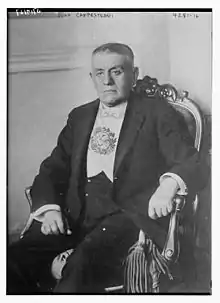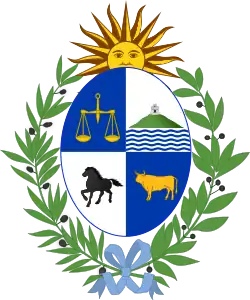Juan Campisteguy
Juan Campisteguy Oxcoby (7 September 1859 – 4 September 1937) was a Uruguayan soldier, lawyer, and President of Uruguay (1927–1931).
Juan Campisteguy | |
|---|---|
 Oxcoby in 1917 | |
| 25th President of Uruguay | |
| In office 1 March 1927 – 1 March 1931 | |
| Prime Minister | José Batlle y Ordóñez Luis C. Caviglia Baltasar Brum |
| Preceded by | José Serrato |
| Succeeded by | Gabriel Terra |
| Personal details | |
| Born | 7 September 1859 Montevideo, Uruguay |
| Died | 4 September 1937 (aged 77) Montevideo, Uruguay |
| Political party | Colorado Party |
| Occupation | Politic, lawyer, soldier |
Biography
He was born in Montevideo.[1]
Son of a soldier in the Great Siege of Montevideo, Campisteguy ended law studies in 1887. He participated in the Revolution of Quebracho and wrote in the newspaper El Día. He was Minister of Finance in 1899. He was Interior Minister from 1903 to 1904. He served as the President of the Senate of Uruguay in 1905.[2]
Campisteguy was formerly a close political ally of the long-serving, liberal President of Uruguay José Batlle y Ordóñez, although he subsequently maintained a more independent political relationship within the Uruguayan Colorado Party.
He served as member of the National Council of Administration in 1921. Later, as President of Uruguay between 1927 and 1931. It was while Campisteguy was President in 1927 that women first exercised the vote in a local election (The Plebiscite of Cerro Chato of 1927).[3]
Campisteguy was succeeded as President by Gabriel Terra.
He died in Montevideo in 1937.
References
- Biografías y Vidas. "Juan Campisteguy – Biografía" (in Spanish). Retrieved 28 April 2011.
- PRESIDENCIA DE LA ASAMBLEA GENERAL Y DEL SENADO PRESIDENCIA DE LA CAMARA DE REPRESENTANTES (29 October 2013). "Parlamentarios Uruguayos 1830–2005" (PDF). www.parlamento.gub.uy. Archived from the original (PDF) on 29 October 2013.
- 'Plebiscito de Cerro Chato de 1927', Wikipedia es:Plebiscito de Cerro Chato de 1927 (in Spanish)
Further reading
- Lindahl, Göran E., Uruguay's New Path: A Study in Politics During the First Colegiado, 1919–33 (1962).
